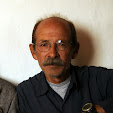Wednesday, 4 April (Rawanduz, Iraqi Kurdistan)
Zrar and I walked into the small electrical supply shop on Rawanduz's single-street market area that snakes uphill along the edge a sharp canyon that defines one edge of the town. Korek Mountain fills the entire horizon ahead, its upper third still capped in snow.
The narrow store is sparsely stocked, but even so, at first Taeib is easy to miss, as he is nestled in the darkened back, far from the raw daylight. Taeib's smooth-skinned and sharp-nosed face glows in the light of the computer screen. His steel blue eyes dance for his whole body.
Taeib is in his wheelchair, but to say he is sitting would be misleading. There seem to be no legs (but there were, neatly tucked in the sides of the wheelchair's frame) and his torso is twisted and shrunken. His left arm too had disappeared; his right supports what he has - a thumb and index finger to navigate through his ever-shrinking physical world. In his black jacket and gray scarf, his radiant head seems to float in the darkness.
He operates his electric wheel chair with a toggle, and computer with a modified mouse. Five small colored lights show brightly from the wheelchair control, and a blue light blinks on the BlueTooth in his ear. His mobile phone hangs from a lariat around his neck.
Zrar, a story unto his 75-year old self, is Taeib's friend, as seem to be everyone in Rawanduz and beyond. How could it be not so? He introduces us, and Taeib warmly welcomes me in slightly reedy voice. I lightly shake his two good digits, sit next to him, and we immediately start talking about photography. Crisply, but slowly nonetheless, Taeib first takes us to my website. He looks at the photographs with intent and approval, asking a few questions but mostly not.

Taeib was born in 1975. I ask him about his condition, and although Zrar wanted to just tell me the story that he knows so well, I urge him to simply translate, which he graciously does. Taeib was born with weak legs which were braced and almost useless by the age of five. Whether he had answered such questions too many times before, or he simply felt compelled to memorialize his story, I don't know, but he pulled up a file of photos of him on the computer, each year labeled at the bottom. A blurry black-and-white photograph of a happy and seemingly normal 2-year old; a portrait with questioning eyes, 1980.
Five minutes through a lifetime: 1985, 1988, 1992 ... 2003, watching his body succumb to gravity in a march of wheelchairs, but always exuding a confidence of acceptance, and always surrounded by others. No pity parties to be seen, and none to be enjoined on this warming afternoon.
A customer walks in and being directed by Taeib, finds what he needs. He comes back to pay, placing two 1,000 dinar notes under the corner of the wheelchair's cushion, chats a bit, and leaves, a mundane ritual to be repeated several times during my unannounced visit.
In his straight but steepening road of adjustments - there never have been improvements in his condition - Taeib has redirected his considerable artistic talents from drawing to computer graphics. We look at his bold graphic computer designs of posters for land mine awareness. Many mines lay in stealth throughout the region from past conflicts; some still send victims to wheelchairs and coffins.
In 2005 he could no longer hold a pen. With several clicks of the mouse we move on to look at his colored ball-point pen drawings that are amazing in all regards - from technique of detailed textures, to sinuous compositions, to extraordinary color balance. How personal they must be. One hangs next to the computer. Pastel colored, it suggests two entwined hands reaching upward, or is a heart, or flowers on the verge of blooming? I do not ask, although others must have, as Taeib has had showings of his work in Kurdistan.
Tucked in the corner of the frame is a small black-and-white photograph of Qazi Mohammed, the President of the short-lived and sole Republic of Kurdistan 65 years ago. He was hung by the Iranian government in 1947.
Other old photographs checker the high walls: Rawanduz 50 years ago, and many of small groups of
peshmergha, Kurdish freedom fighters, in the mountains. Taeib has become Rawanduz's unofficial photographic archivist, scanning and storing images brought to him. The mayor, Serwan Sirini, officially recognized him for these efforts this year past.
A heater glows orange a foot away from our knees. Taeib says he is always cold, especially his legs.
Later, a small pick-up truck arrives. Taeib's younger brother and owner of the shop, with two others, lift Taeib and his wheelchair into the back of the truck. They are going home.
To see some of Taeib's art and photographic collection, you can visit
Taeib M Aziz on Facebook (open access), or go to www.panoramio.com/user/4959155.
Images of Taeib and his work used with his permission.





















